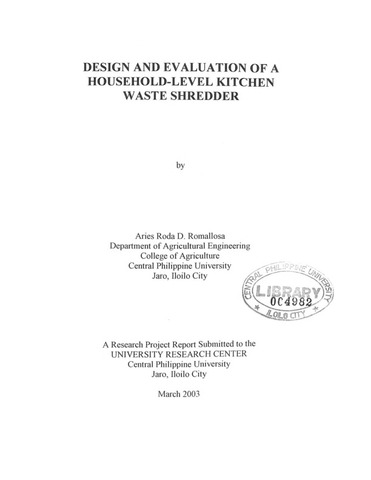Design and evaluation of a household-level kitchen waste shredder
| dc.contributor.author | Romallosa, Aries Roda D. | |
| dc.date.accessioned | 2021-05-11T02:38:59Z | |
| dc.date.available | 2021-05-11T02:38:59Z | |
| dc.date.issued | 2003-03 | |
| dc.identifier.citation | Romallosa, A. R. D. (2003). Design and evaluation of a household-level kitchen waste shredder (Research report). Jaro, Iloilo City : University Research Center, Central Philippine University. | en_US |
| dc.identifier.uri | https://hdl.handle.net/20.500.12852/842 | |
| dc.description | Abstract only | en_US |
| dc.description.abstract | The study was carried out from October and November 2002 at the Department of Agricultural Engineering, College of Agriculture, Central Philippine University. The objective of the study was to design and evaluate the performance of a shredder used for chopping and shredding kitchen wastes. The machine basically consists of the following parts, namely: (a) movable feeding hopper, which guides the kitchen wastes to the shredding cylinder during feeding; (b) shredding cylinder, which encloses the shredding plate and cutter; (c) shredding plate, which is responsible for the cutting and beating of the waste materials; (d) frame assembly, which supports the shredding cylinder and plate; and (e) motor and transmission assemblies, which supply the power for the machine. The shredding plate consist of two beaters responsible for disentangling the cellular structure of the waste materials for ease of cutting into smaller pieces. It is also equipped with a stopper to prevent the materials from directly going to the discharge chamber without undergoing rigid operation of shredding. Beneath it is a discharge chamber that serves as an outlet for the shredded materials. The plate is driven by a ½-Hp single-phase electric motor through a v-belt drive. The whole assembly is fixed into a support frame for ease of steering the machine. The operation of the machine follows the principle of a simple blender in which waste materials are fed at the hopper and are allowed to pass through the shredding cylinder where they undergo cutting and shearing actions by the cutters and beaters. Shredded materials leave the machine through a discharge chamber in one passing. Results of the performance evaluation show that the shredder has an average shredding capacity of 0.71 kg per min. The shredder has an electric power input of 478.67 watts at 8-hour operation. The specific capacity of the shredder, based on the number of cutter and beater, is 0.18 kg per min and 0.36 kg per min, respectively. Volume reduction of waste is 33.27 percent. The machine can be fabricated in small shops at a cost of P15,000.00 including the electric motor. With one person to operate the machine, it entails an operating cost of P0.58 per kg of shredded waste. The machine performs satisfactorily as to the design. It has high capacity and can effectively reduce the size of waste materials. It can be fabricated in small shops and can be produced with low initial and operating cost. | en_US |
| dc.format.extent | vii, 27 leaves | en_US |
| dc.language.iso | en | en_US |
| dc.publisher | Central Philippine University | en_US |
| dc.rights | Attribution-NonCommercial-NoDerivs 3.0 Philippines | * |
| dc.rights.uri | http://creativecommons.org/licenses/by-nc-nd/3.0/ph/ | * |
| dc.subject.ddc | GSL 630.72 R661 | en_US |
| dc.subject.lcsh | Compost | en_US |
| dc.subject.lcsh | Refuse and refuse disposal | en_US |
| dc.subject.lcsh | Agricultural machinery | en_US |
| dc.subject.lcsh | Agricultural machinery--Design and construction | en_US |
| dc.subject.lcsh | Refuse and refuse disposal--Equipment and supplies | en_US |
| dc.title | Design and evaluation of a household-level kitchen waste shredder | en_US |
| dc.title.alternative | Design and evaluation of a household level kitchen waste shredder | en_US |
| dc.type | Technical Report | en_US |
| dcterms.accessRights | Limited public access | en_US |
| dc.description.bibliographicalreferences | Includes bibliographical references | en_US |
| local.subject | Shredders--Design and construction | en_US |
Fichier(s) constituant ce document
Ce document figure dans la(les) collection(s) suivante(s)
-
Research reports [167]
-
Research reports [37]



